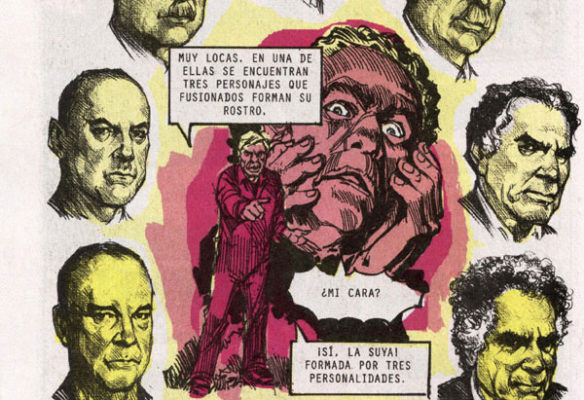Search
To search for an exact match, type the word or phrase you want in quotation marks.
A*DESK has been offering since 2002 contents about criticism and contemporary art. A*DESK has become consolidated thanks to all those who have believed in the project, all those who have followed us, debating, participating and collaborating. Many people have collaborated with A*DESK, and continue to do so. Their efforts, knowledge and belief in the project are what make it grow internationally. At A*DESK we have also generated work for over one hundred professionals in culture, from small collaborations with reviews and classes, to more prolonged and intense collaborations.
At A*DESK we believe in the need for free and universal access to culture and knowledge. We want to carry on being independent, remaining open to more ideas and opinions. If you believe in A*DESK, we need your backing to be able to continue. You can now participate in the project by supporting it. You can choose how much you want to contribute to the project.
You can decide how much you want to bring to the project.

A group exhibition, that explores research methodologies and the need to look at the world as an enigma. “Modelling Standard” is shown in a private gallery but could equally be in a museum.
Is there some point of union between Aby Warburg, George Steiner, Sir Arthur Conan Doyle, Matt Mullican and Sigmund Freud? What do the late writer, Ambrose Bierce, the Wizard of Oz, the Piltdown man and Freud’s dog have in common? A priori, not much. However, working with the research methodology of the Microhistory, the artists Jorge Satorre and Erick Beltrán have organised (more than curated) the group show, “Modelling Standard” in which they offer some answers.
The fact that they don’t figure as curators allows them to articulate their ideas with the collaboration of a long list of participants, in which figure artists, (Christoph Keller, Raphaël Zarka, Paloma Polo, Bernardo Ortiz, Efrén Álvarez, Meris Angioletti, Jose Antonio Vega Macotela and Florian Göttke), illustrators (Jorge Aviña) and scientists (Vilayanur Ramachandran). It also allows them to unfold their ideas in the form of two pieces that slowly discover, trace and unravel all the elements that link the people and characters mentioned at the beginning. The chosen form is double, a comic “El hallazgo del miembro fantasma” (The discovery of the phantom member), laid out on the wall, and a network of caricatures and texts at the end of the exhibition, in which all the famous protagonists participate – as victims or executioners – in a major crime. And to close the circle, the exhibition is finally set in motion with the talk given by both artists during the opening.
With intelligence, erudition and a great sense of humour, Jorge Satorre and Erick Beltrán have known how to organize an exhibition that while it is in a private gallery could equally be presented in an art centre. Following a scientific methodology, the Micro-history, and with a reference book, “Huellas. Raíces de un paradigma indiciario” (Traces. The roots of an indicative paradigm)(1978) by Carlo Ginzburg, they articulate a series of pieces which evidence strange things, enigmas and mysteries that are not always resolved and which conceal murky intentions. Let me enumerate them: filmed sequences, retrieved from the bottom of a lake, that recorded experiments with hypnosis to induce a crime (Christoph Keller); the exchange of time (and experiences) with prison inmates (Jose Antonio Vega Macotela); a sound installation susceptible to being converted into an image (Meris Angioletti); secret or inexistent novels (Bernardo Ortiz); the fascination for a geometric form, the rhombicuboctahedron, and its appearance in architecture, paintings and objects (Raphaël Zarka); the reading of the eclipses (Paloma Polo); the doubles of Saddam (Florian Göttke), socio-critical and political drawings-diagrams-caricatures (Efrén Álvarez) and neurological experiments with people who have lost one of their body parts (Vilayanur Ramachandran).
Rather than converting the presentation of these works into mere appendices of their idea, on the contrary, the artists Satorre and Beltrán, have known how to soften their erudition and bombardment of references with a layer of popular culture, pouring their ideas into a comic, illustrated by Jorge Aviña, the author of the classic “El libro vaquero”(The Western Book). The comic “El hallazgo del miembro fantasma” proposes, in a way that is both clear and effective, and goes without saying entertaining, a reflection on the image and the need “to see hidden images in objects, to organize them and to find relations between them”[sic].
And in the middle of this, it doesn’t seem crazy to mention Dr. House. It seems that medical students are taught that if they hear the sound of hooves they must think of horses and not of zebras. House uses other methods: “I look for zebras because the other doctors have ruled out horses”. It seems that Satorre and Beltrán also pursue zebras. Employing a method that allows them, to look for clues, symptoms and fragmentary testimonies, to reduce the scale and exhaustively analyse the sources. “Modelling Standard” seems like a brief stop on a longer journey during which, without a doubt, new discoveries and investigations can be added and expanded. It is also a good example of the road map followed by contemporary art practices. Namely of employing research methodologies proceeding from other ambits for the establishment of relations and crossovers with other scientific disciplines, the coexistence of references of so called high and low culture, and the exploration of narrative and other experiential aspects.
(Image: Jorge Satorre y Erick Beltrán, “El hallazgo del miembro fantasma”, 2011 (The discovery of the phantom member))

Montse Badia has never liked standing still, so she has always thought about travelling, entering into relation with other contexts, distancing herself, to be able to think more clearly about the world. The critique of art and curating have been a way of putting into practice her conviction about the need for critical thought, for idiosyncrasies and individual stances. How, if not, can we question the standardisation to which we are being subjected?
www.montsebadia.net
"A desk is a dangerous place from which to watch the world" (John Le Carré)